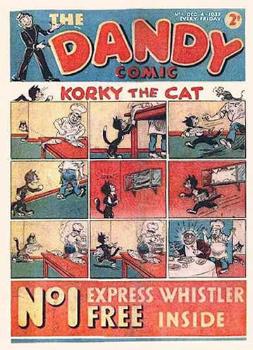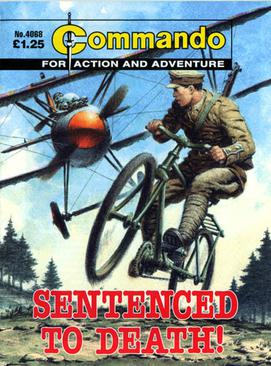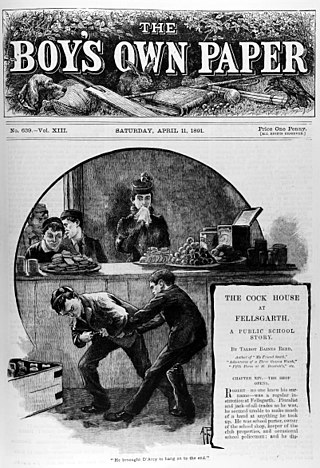Related Research Articles
The Beano is a British anthology comic magazine created by Scottish publishing company DC Thomson. Its first issue was published on 30 July 1938, and it became the world's longest-running comic issued weekly in 2018, publishing its 4000th issue in August 2019. Popular and well-known comic strips and characters include Dennis the Menace, Minnie the Minx, The Bash Street Kids, Roger the Dodger, Billy Whizz, Lord Snooty and His Pals, Ivy the Terrible, General Jumbo, Jonah, and Biffo the Bear.

The Dandy was a British children's comic magazine published by the Dundee based publisher DC Thomson. The first issue was printed in December 1937, making it the world's third-longest running comic, after Il Giornalino and Detective Comics. From August 2007 until October 2010, it was rebranded as Dandy Xtreme.
A British comic is a periodical published in the United Kingdom that contains comic strips. It is generally referred to as a comic or a comic magazine, and historically as a comic paper.

Commando For Action and Adventure, formerly known as Commando War Stories in Pictures, and colloquially known as Commando Comics, is a British comic book magazine that primarily draws its themes and backdrops from the various incidents of the First and Second World Wars. It was first published in July 1961 and is still in print today. It is noted for its distinctive 7 × 5½ inch, 68 page format that became a standard for these kinds of stories. "Commando" has remained more popular than many other British war comics, because of its character based stories and detailed black and white artwork, with only the covers in colour.

Knockout may refer to one of two British comics. The original series, published by the Amalgamated Press, started on 4 March 1939 and ended on 16 February 1963, when it merged with Valiant. The second series, published by IPC Magazines, ran from 12 June 1971 to 23 June 1973, when it merged with Whizzer and Chips.

Wizard or Wizard: The Magazine of Comics, Entertainment and Pop Culture was a magazine about comic books, published monthly in the United States by Wizard Entertainment from July 1991 to January 2011. It included a price guide, as well as comic book, movie, anime, and collector news, interviews, and previews.

witzend, published on an irregular schedule spanning decades, is an underground comic showcasing contributions by comic book professionals, leading illustrators and new artists. witzend was launched in 1966 by the writer-artist Wallace Wood, who handed the reins to Bill Pearson from 1968 to 1985. The title was printed in lower-case.
In American comic books and other stories with a long history, first appearance refers to the first issue to feature a fictional character. These issues are often highly valued by collectors due to their rarity and iconic status.
Ronald George Smith was an English comic artist whose career spanned almost fifty years. Primarily producing strips for the two main publishers, DC Thomson and IPC Magazines, Smith was best known for drawing Judge Dredd for 2000 AD and the Daily Star.

Action was a controversial weekly British children's anthology comic that was published by IPC Magazines, starting on 14 February 1976, until November 1977.

Moonstone Books is an American comic book, graphic novel, and prose fiction publisher based in Chicago focused on pulp fiction comic books and prose anthologies as well as horror and western tales.
Classics from the Comics was a British comics magazine, published from March 1996 until October 2010. Published monthly, it was D. C. Thomson & Co. Ltd's third all-reprint comic. It replaced The Best of Topper and The Best of Beezer, which had reprinted old strips for some years.
The Victor was a British comic paper published weekly by D. C. Thomson & Co. Ltd. The Victor ran for 1,657 issues from 25 January 1961 until it ceased publication on 21 November 1992. Associated with it was the annually published The Victor Book for Boys. This annual was first published in 1964, with the last edition published in 1994. A hardback book, The Best of The Victor, was published in 2010 ready to commemorate the 50th anniversary of this popular adventure comic. The book featured a selection of reprints from the weekly comic.

Magazines intended for boys fall into one of three classifications. These are comics which tell the story by means of strip cartoons; story papers which have several short stories; and pulp magazines which have a single, but complete, novella in them. The latter were not for the younger child and were often detective or western in content and were generally greater in cost. Several titles were published monthly whereas the other two categories were more frequent.
Wilson the Wonder Athlete was a British comic strip, first published in 1943 in the British illustrated story paper The Wizard published by D. C. Thomson & Co. It follows the sporting adventures of a heroic character named William Wilson. The stories were written by Gilbert Lawford Dalton and drawn by Jack Glass. The stories ran until 1984 in various British magazines.
Ian Kennedy was a British artist who worked initially for D. C. Thomson & Co. Ltd, then later for Amalgamated Press.

The Hotspur was a British boys' paper published by D. C. Thomson & Co. From 1933 to 1959, it was a boys' story paper; it was relaunched as a comic in October 1959, initially called the New Hotspur, and ceased publication in January 1981.
William Sampson or Samson, the Wolf of Kabul, was a literary character in British boys' papers published by D. C. Thomson & Co. He first appeared in The Wizard in 1922.

Anthony John "Tony" Harding was a British illustrator of boys' action comics specialising in football stories. He worked for D. C. Thomson & Co. and IPC Magazines in a career that spanned over 30 years, on comics such as Bullet, Scorcher, Hornet, Action, Roy of the Rovers, Victor and Scoop, amongst others.
References
- ↑ Paul Sassienie, The Comic Book: The One Essential Guide for Comic Book Fans Everywhere, Edison, New Jersey: Chartwell, 1994, p. 252.
- ↑ Jeremy Briggs, "Calling Warlord Agents!" Archived 25 May 2011 at the Wayback Machine Interview with Bill Graham, Downthetubes.com: "August 5th, 1963. I remember it like it was yesterday. I was put on the staff of The Hornet on the day the first issue went to press".
- ↑ Roger Sabin, Comics, Comix & Graphic Novels, London: Phaidon, 1996, repr. 2001, ISPN 0-7148-3993-0, p. 49: "DC Thomson hit back [after the launch of Eagle] . . . by launching new titles, the most famous of which were Victor (1961) and Hornet (1963)."
- 1 2 The Hornet at 26pigs.com.
- ↑ Mike Conroy, War Stories: A Graphic History, New York: Ilex/Harper, 2009, ISBN 978-0-06-173112-9, p. 116.
- ↑ Graham Kibble-White, The Ultimate Book of British Comics, London: Allison & Busby, 2005, ISBN 0-7490-8211-9, p. 218.
- ↑ Paul Gravett and Peter Stanbury, Great British Comics: Celebrating a Century of Ripping Yarns and Wizard Wheezes, London: Aurum, 2006, ISBN 978-1-84513-170-8, p. 166.